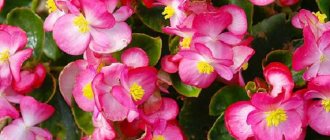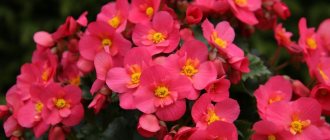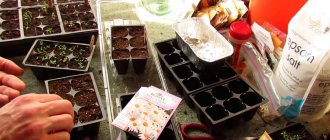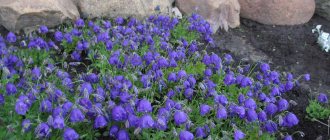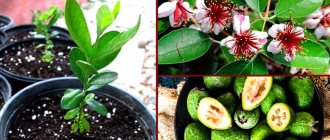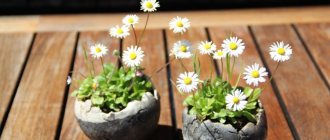A luxurious flower known under the secret name “Japanese lantern” will help the gardener decorate the front garden near the house in an oriental style. Millions of gardeners enjoy growing fuchsia in the garden and caring for it. She is unpretentious and feels great in the flowerbed. Since garden fuchsia is a hybrid variety, it is important to create suitable conditions for it. To do this, it is important to know the intricacies of planting and caring for a flower.
Description of the plant
Fuchsia belongs to the perennials; its genus includes more than a hundred species. Previously, its popularity was not so high, but with the advent of hybrids, which acquired the ability to reproduce using seeds and bloom in the first year of cultivation, the situation has changed radically. The plant has a long flowering period, which makes it possible to grow it as an annual plant. Fuchsia in the garden continues to remain a perennial, despite the appearance of various modifications of the variety.
The plant has fibrous roots and green or reddish leaves. In shape they resemble an oval with pointed jagged edges. Fuchsia in the garden, the cultivation and care of which are described in this article, cannot but captivate with its flexible branches on which flowers are located on long stalks.
The color range of flowers is represented by pink and purple shades in various tones. Sometimes one flower can combine several tones at the same time - it depends on the variety. The fruits of this plant are edible berries.
Fuchsia trifoliata
Fuchsia, the cultivation and care of which has some peculiarities in the garden, can be represented by a rather rare species: three-leaved. It is a shrub up to 50 cm high, has a rhizome and is distinguished by reddish-green foliage. Its inflorescences are short, formed from bright coral flowers. This variety is very hardy and therefore suitable for successful cultivation in open ground.
The plant can be classified due to the varied colors of its flowers. Fuchsia in the garden, the cultivation and care (photo above), which is described in this article, is also represented by winter-hardy varieties. They can winter in open ground even without special shelter.
Features of cultivation and care
Fuchsia in the garden, cultivation and care, the propagation of which is described in this article, is generally a heat-loving plant. The only exceptions may be separately bred hybrids that exhibit comparative frost resistance. Windless and well-lit corners of your garden may be ideal for growing it. Light shading may be beneficial.
Fuchsia in the garden can easily grow in open ground. It can be planted there already in early May. In this case, a very important point is that the root collar should not be buried when planting the plant. If rooting is successful, then in a couple of weeks your pet can please you with its flowering.
Fuchsia in the garden, the cultivation and care of which is described in this article, can also grow in a pot. For this option, it is better to take a plant a couple of years old and with a well-developed root system. In this case, the pot can be either buried or simply placed in a recess.
Fuchsia in the garden, the cultivation and care of which in winter has specific features, should not be left in the open ground during the cold period. That is why it is impractical to completely transfer their root system into the ground. Approximately at the end of autumn, the plant is sent indoors for the winter.
Landing instructions
The easiest way to grow is to plant fuchsia in a pot or hanging basket that will hang on the veranda. This type of planting is not so problematic, because when frost sets in, the flower can simply be brought into the house and not be replanted again. For experienced gardeners, it will not be difficult to plant a plant in a flowerbed, but in this case you need to think carefully about the planting location.
Fertilizer
It doesn’t matter where in the garden the flower will be located in a basket or in a flowerbed, the composition of the soil and fertilizer is of great importance . Before planting, it is necessary to add a sufficient amount of humus and phosphorus fertilizers.
For fuchsia, the type of fertilizer can be distributed according to growth phases:
- Young plants need a complex fertilizer that contains a large amount of nitrogen. This component of the fertilizer helps to accelerate the growth of the plant and its greening.
For a grown flower, fertilizers with a high content of potassium and phosphorus are best suited, which will help the plant produce a large number of buds for flowering.
Features of care
Fuchsia, depending on the variety, may have certain growing characteristics, but most often it prefers direct sunlight in the morning, but it is necessary to create artificial shading from lunch until the evening so that the plant does not get burned. Only a few varieties love sunbathing and are able to tolerate it painlessly. These are mainly plants with brightly colored flowers.
Fuchsia in the garden, the cultivation and care of which are described in this article, requires moderate summer temperatures, which average 16-22 degrees. If the temperature is lower, the plant may enter a dormant period and buds will not form. An increase in temperature may cause the buds to drop and your pet to become ill. If it is not possible to control the temperature, then the humidity level should be increased.
Fuchsia is a tropical plant, so it loves various water treatments. Spraying has a very beneficial effect on it, especially after a hot summer day.
Possible problems
Fuchsia reacts extremely negatively to stagnant air, so during the growing season the room where the flower is located must be systematically ventilated, or the pot with the plant can be moved to the balcony.
Fuchsia fades quickly
There are several reasons why the bush fades relatively quickly:
- if in winter the bush was watered abundantly and it was warm;
- if during the spring-summer period the lighting was excessively poor;
- if the bush was fed and watered less often than necessary in the summer.
Fuchsia leaves are falling
If the foliage flies away in winter, then the bush must be removed from bright light, while the developing buds must be pinched. Flying leaves can also be associated with excessively poor watering, too low air humidity and very high temperatures. Fuchsia can drop its buds if there is excessively poor lighting, untimely watering and very high air temperatures.
Spots on fuchsia leaves
The bush becomes affected by spotting if it is watered too often in winter.
Fuchsia has dropped its buds
During the period of bud formation and flowering, it is forbidden to disturb the bush, since if it is rearranged or rotated, then all its buds will fly off. If a flower is exposed to a draft, its buds will also fall off.
Harmful insects
Most often, spider mites and whiteflies settle on such a plant.
For beginners about fuchsias
Soil selection
Fuchsia is not demanding on soil, but it prefers light and fertile soil with neutral acidity. To improve its structure, you can add a little high-moor peat, sand and perlite. It will be beneficial to add clay, which retains nutrients in the soil and prevents them from being washed out. For adult plants, soil with the addition of turf, compost, humus, soil with leaves, peat, etc. is recommended.
The soil should maintain constant moisture or strive to do so. In order to comply with this condition, you do not need to wait until the top layer is completely dry; you should water the plant regularly. If watering is insufficient, fuchsia may shed its leaves and buds prematurely. However, overwatering can lead to very negative consequences, so you should be as rational and careful as possible.
Following actions
The basic rules of care are choosing the right location, watering and humidity. If a florist makes mistakes, the following signs indicate this:
- The leaves fall and the flowers wither - fuchsia does not receive enough moisture.
- The entire bush withers - there is an excess of moisture in the soil, the roots begin to rot.
- Brown spots appear on the foliage - regulation of the frequency of watering is required, as the soil becomes waterlogged.
Caring for the plant involves the mandatory application of organic fertilizers - mullein or low concentration humus, ash. During the formation of buds and during the flowering period, the application of instant fertilizers is required.
On a note. It is necessary to carry out high-quality pruning of fuchsia. To do this, dry or weakened shoots should be removed, and actively growing tops should be shortened by half.
Shaping and trimming
Forming a fuchsia bush must begin from the cuttings. This plant is very flexible for molding and responds favorably to it. You can give the bush any shape you want, it all depends only on your imagination. However, it is important that prolonged pinching can significantly slow down flowering, so it is important not to overdo it in this matter. The procedure can be continued after the first fuchsia bloom.
As for pruning, it is best done at the end of the growing season. At this time, all flower-bearing branches located at a height of 2 cm from the dormant buds are removed. The final crown molding is carried out around January.
Fuchsia ampelous in the garden: cultivation and care
Hanging varieties of fuchsias are best suited for growing in hanging baskets. However, this does not stop some gardeners from planting them in their beds. This is a very controversial decision, which some consider original, while others consider it unacceptable.
In terms of requirements for choosing a place of growth and care, ampelous fuchsia is very similar to ordinary fuchsias. However, it does best in a wire basket filled with peat moss. When choosing the plant itself, it is better to give preference to those with good roots, but not too developed.
Reproduction
Seeds . This method provides an opportunity to obtain your own breeding varieties. Growing fuchsia from seeds is fraught with the loss of the original varietal traits of its parents. Start working in March-April. Place the seeds in special containers, lightly sprinkled with substrate, or take peat tablets for sowing. They are immediately transplanted into the ground without disturbing the root of the seedling. After sowing, keep the container at a temperature of 16-18 C; the first shoots will appear in about 3 weeks.
Vegetatively . This method involves cuttings. Slightly woody shoots are suitable for this purpose. Root them in a jar of water or make a liquid earthen substrate. Within 1-2 weeks the first roots will grow. Bush and ampel species are cut once every three years, in this way, rejuvenating them. Fuchsia trifolia propagates only by cuttings.
Wintering fuchsia directly in the garden
Contrary to popular belief, some varieties of fuchsia are able to overwinter in open ground. This is Magellan fuchsia. It can be covered with spruce branches, and it will feel great under the snow. Other species require preparatory measures before leaving for the winter.
Before the onset of persistent cold weather, fuchsia should be cut at soil level and sprinkled with a layer of soil of at least 20 cm. After this, cover with spruce branches and provide insulation from excess moisture. The plant should be opened around mid-May. After such a winter, fuchsia blooms around August.
Gardeners also practice such a method as annual rooting of new cuttings. The plant itself is not left in the fall.
How to take cuttings correctly
Having chosen a plant for propagation, you need to cut off part of the shoot at an angle. The upper part also needs to be cut at an angle, leaving only one internode. It is recommended to cut the remaining leaves in half, this will significantly reduce evaporation.
The prepared cuttings can be only about 5 cm, this is enough to create a new beautiful plant in the future. The finished cutting is placed in moist soil or perlite and sprayed with water.
Perlite is an excellent material for rooting Fuchsia cuttings. After 2 months, the young plants will take root and they will be ready to be transplanted to a permanent location.



